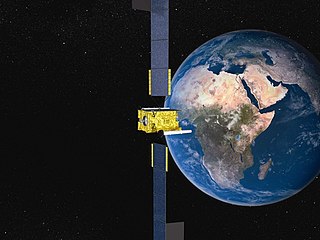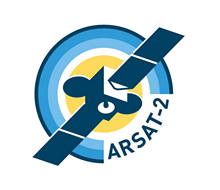
Ariane 5 is a European heavy-lift space launch vehicle developed and operated by Arianespace for the European Space Agency (ESA). It is launched from the Centre Spatial Guyanais (CSG) in French Guiana. It has been used to deliver payloads into geostationary transfer orbit (GTO) or low Earth orbit (LEO). The launch vehicle had a streak of 82 consecutive successful launches between 9 April 2003 and 12 December 2017. Since 2014, Ariane 6, a direct successor system, is in development.

The Guiana Space Centre, also called Europe's Spaceport, is a European spaceport to the northwest of Kourou in French Guiana, an overseas department and region of France in South America. Kourou is located approximately 310 mi (500 km) north of the equator, at a latitude of 5°. In operation since 1968, it is suitable as a location for a spaceport, because of its equatorial location and open sea to the east.

Vega is an expendable launch system in use by Arianespace jointly developed by the Italian Space Agency (ASI) and the European Space Agency (ESA). Development began in 1998 and the first launch took place from the Centre Spatial Guyanais on 13 February 2012.
Spaceway-2 is part of DirecTV's constellation of direct broadcast satellites. The satellite was launched via an Arianespace Ariane 5 ECA rocket from Kourou, French Guiana on 16 November 2005. Its operational position is in geosynchronous orbit 35,800 kilometres (22,200 mi) above the equator at 99.2° West longitude. Spaceway-2 is a Boeing 702-model satellite with a 12-year life expectancy. It is expected to support high-definition television to DirecTV customers with its Ka-band communications payload. Although Spaceway-2 was originally built by Boeing to be used for broadband Internet access via Hughes Network Systems, it has been retrofitted to deliver HD local channels to numerous markets nationwide.
HYLAS is a British satellite in geostationary orbit. HYLAS, which is an acronym for Highly Adaptable Satellite, is a communications satellite and was launched by the European Ariane 5 launch vehicle from the Guyana Space Centre at Kourou in French Guiana. It is located at the orbital location of 33.5 degrees west and will provide new and innovative services including High Definition Television (HDTV) and interactive satellite delivered broadband services. The satellite will help address the issue of poor broadband coverage in many parts of Europe which have less developed ground infrastructure.

ELA-3, is a launch pad and associated facilities at the Centre Spatial Guyanais in French Guiana. ELA-3 is operated by Arianespace as part of the expendable launch system for Ariane 5 launch vehicles. As of December 2021, 112 launches have been carried out from it, the first of which occurred on 4 June 1996.
Satmex was a company set up in Mexico in the mid-1990s through 2014 that operated space communication satellites that provide services to the Americas.
Optus D3 is an Australian geostationary communications satellite, which is operated by Optus and provides communications services to Australasia. D3 was the third Optus-D satellite to be launched. It is a 2,401-kilogram (5,293 lb) satellite, which was constructed by Orbital Sciences Corporation based on the Star-2.4 satellite bus, with the same configuration as the earlier Optus D2 satellite.

The Ensemble de Lancement Soyouz (ELS) is a launch complex at the Guiana Space Centre in Kourou/Sinnamary, French Guiana. It is used by Soyuz-ST rockets: modified versions of the Soyuz-2 optimised for launch from Kourou under Soyuz at the Guiana Space Centre programme.
JCSAT-RA, previously known as JCSAT-12, is a Japanese geostationary communications satellite, which is operated by SKY Perfect JSAT Group.
Yahsat 1A is a communications satellite constructed by EADS Astrium and Thales Alenia Space for Al Yah Satellite Communications Company (Yahsat). It was launched in April 2011 from Arianespace's Guiana Space Centre in Kourou French Guiana in a dual payload launch with Intelsat New Dawn atop an Ariane 5 ECA rocket. Yahsat Y1A is based on the Eurostar E3000 satellite bus and had a launch mass of about 6000 kg. It is intended to provide Ku, Ka and C-band communications to the Middle East, Africa, Europe and Southwest Asia. It is in geosynchronous orbit at 52.5 degrees East.
Eutelsat 21B, previously known as Eutelsat W6A, is a French communications satellite. Operated by Eutelsat, it provides direct to home broadcasting services from geostationary orbit at a longitude of 21.5 degrees east. It replaced the Eutelsat 21A spacecraft which was launched in 1999.

Skynet 5D is a military communications satellite operated by Airbus Defence and Space on behalf of the British Ministry of Defence. It was the last of four Skynet 5 satellites to be launched.
The Mexican Satellite System, also known as MEXSAT, is a network of three satellites bought by the Mexican government's Ministry of Communications and Transportation. The three satellites are named Mexsat-1, Mexsat-2, and Mexsat-3. Subsequently, they have also been named Centenario, Morelos III and Bicentenario respectively.

ARSAT-2 is a geostationary communications satellite operated by ARSAT and built by the Argentine company INVAP. It was launched from French Guiana alongside Sky Muster satellite using an Ariane 5ECA rocket on September 30, 2015 at 20:30hs UTC, becoming the 400th satellite to be launched by Arianespace. It is licensed to be located at 81° West longitude geostationary slot. ARSAT-2 is the second geostationary satellite built in Argentina, after ARSAT-1. Structurally and mechanically it is a copy of the ARSAT-1, the only difference being the payload and thus it has different antenna configuration.
Spainsat is a Spanish telecommunications satellite used for military and government communications. It allows telecommunications the different missions of the Spanish Armed forces abroad by providing coverage on a wide area of the world ranging from the United States and South America to the Middle East, including Africa and Europe.

GSAT-18 is an Indian communications satellite. Built by ISRO and operated by INSAT, it carries 24 C-band, 12 extended C-band, and 12 Ku-band transponders.
HYLAS-4 is a telecommunications satellite owned and operated by Avanti Communications and manufactured by Orbital ATK that was launched by an Ariane 5 rocket on 5 April 2018.
STENTOR was a French communications satellite which was lost in a launch failure in 2002. Intended for operation by CNES, France Telecom, and Direction générale de l'armement (DGA). To validate, in flight, advanced technologies which would be integrated in the next generation of telecommunications spacecraft. It will also demonstrate new telecommunications services, including broadband and multimedia transmissions to small user terminals.







